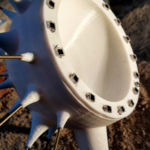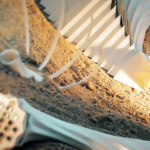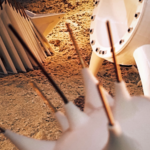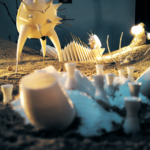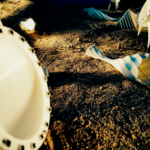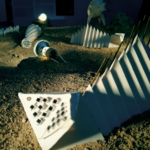campos elíseos
A instalação “Campos Elíseos” trata da relação entre o ser humano e a natureza. Seu título faz referência ao lugar descrito na Mitologia Grega como o Paraíso, onde todos os que lá estão convivem harmonicamente. Neste caso, uma utopia onde todos os seres têm igual poder e voz, independentemente de sua origem, forma ou espécie. A obra trata do comportamento humano em relação à natureza como algo predatório, destruindo suas fontes e impondo a dinâmica conquistatória que lhe é particular. Aqui, os belos campos idealizados pelos gregos se transformam em uma terra árida, onde os únicos seres que conseguiram sobreviver à ação humana foram os artificiais, autônomos, que dependem apenas de luz como fonte de energia. É um alerta sobre o modo como estamos tratando o planeta e sobre o que acontecerá nos próximos anos caso não mudemos nossa postura.
Os seres propostos aqui estão em algum lugar entre os limites da natureza, em um hiato situado entre os reinos animal e vegetal. O título da instalação faz referência a um dos raros animais que fazem esta ponte; um híbrido entre fauna e flora – o Elysia Chrolotica – que tem características tanto animais quanto vegetais. Ele é um ser que consegue fazer fotossíntese e assim se alimentar de luz, ao mesmo tempo que mantém atributos animais, como a emissão de sons.
O projeto teve início a partir dos conceitos de autonomia e vida artificial. Seres autônomos são aqueles que conseguem controlar suas entradas e saídas em trocas dinâmicas e estáveis. Este conceito está dentro de estudos na área da Cibernética feitos a partir da metade do século XX, por autores como Norbert Wiener e Gilbert Simondon. Ao contrário dos autômatos, que são fechados a trocas e segundo estes autores tendem a desaparecer, os seres autônomos dialogam com o exterior e com ele realiza trocas constantes, de modo a se adaptar ao ambiente em que está inserido.
Baseado nestes conceitos e em um tema cada vez mais presente em nossa sociedade – a vida artificial – pensei em criar uma instalação composta de seres autônomos que utilizassem um tipo de energia limpa, e se comunicassem entre si por meio de um dialeto próprio, composto por sons característicos de cada espécie. A energia que alimenta estes seres é a luz. Porém, em vez de utilizar paineis solares, resolvi buscar outras maneiras de captar a energia luminosa (do sol ou de fontes artificiais) que me permitissem criar seres interessantes esteticamente, e não tivessem apenas um caráter funcional de acúmulo de energia para alimentar um circuito. A pesquisa iniciou-se com pesquisas na internet sobre energia solar e formas alternativas para sua captação.
Os sons dos seres foram pensados de modo a ter uma relação com sua aparência, seguindo conceitos de artistas modernistas como Kandinsky e Klee, que vinculavam cada forma a um tipo de som específico. Objetos pontudos por exemplo teriam uma sonoridade mais áspera e ruidosa, enquanto os mais arredondados emitiriam sons mais suaves. As formas dos seres também têm a ver
com o tipo de onda que emitem: senoidal, triangular, dente de serra, etc. O canto destes seres é esporádico e acontece em tempos aleatórios, de acordo com a programação feita para cada indivíduo. Estes têm um poder de decisão sobre o tempo, duração, intervalo e a forma melódica do seu canto. O silêncio também está presente no dia-a-dia dos seres, que passam por um período de
hibernação, após deixar de ter contato com a luz por algumas horas e suas baterias se descarregarem. Entretanto, voltam à vida no dia seguinte assim que tenham acesso novamente a uma fonte de luz.
[english]
The installation “Campos Elíseos” deals with the relationship between human beings and nature. Its title refers to the place described in Greek Mythology as Paradise, where everyone there lives harmoniously. In this case, a utopia where all beings have equal power and voice, regardless of their origin, form or species. The work deals with human behavior in relation to nature as something predatory, destroying its sources and imposing the conquering dynamics that are particular to it. Here, the beautiful fields idealized by the Greeks are transformed into an arid land, where the only beings that managed to survive human action were artificial, autonomous ones, which depend only on light as a source of energy. It is a warning about the way we are treating the planet and what will happen in the coming years if we do not change our stance.
The beings proposed here are somewhere between the limits of nature, in a gap between the animal and plant kingdoms. The title of the installation refers to one of the rare animals that make up this bridge; a hybrid between fauna and flora – Elysia Chrolotica – which has both animal and plant characteristics. He is a being that can carry out photosynthesis and thus feed on light, while maintaining animal attributes, such as the emission of sounds.
The project began with the concepts of autonomy and artificial life. Autonomous beings are those that can control their inputs and outputs in dynamic and stable exchanges. This concept is part of studies in the area of Cybernetics carried out since the middle of the 20th century, by authors such as Norbert Wiener and Gilbert Simondon. Unlike automatons, which are closed to exchanges and according to these authors tend to disappear, autonomous beings dialogue with the outside and carry out constant exchanges with it, in order to adapt to the environment in which they are inserted.
Based on these concepts and a theme increasingly present in our society – artificial life – I thought about creating an installation made up of autonomous beings that used a type of clean energy, and communicated with each other through their own dialect, made up of sounds characteristic of each species. The energy that feeds these beings is light. However, instead of using solar panels, I decided to look for other ways of capturing light energy (from the sun or artificial sources) that would allow me to create aesthetically interesting beings, and not just have a functional nature of accumulating energy to power a circuit. The research began with searches on the internet about solar energy and alternative ways to capture it.
The sounds of beings were designed to have a relationship with their appearance, following concepts from modernist artists such as Kandinsky and Klee, who linked each shape to a specific type of sound. Pointed objects, for example, would have a harsher and noisier sound, while rounder objects would emit softer sounds. The forms of beings also have to do with
with the type of wave they emit: sinusoidal, triangular, sawtooth, etc. The singing of these beings is sporadic and happens at random times, according to the programming made for each individual. They have decision-making power over the time, duration, interval and melodic form of their singing. Silence is also present in the daily lives of beings, who go through a period of
hibernation, after no contact with light for a few hours and its batteries are discharged. However, they return to life the next day as soon as they have access to a light source again.
